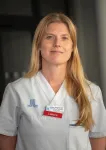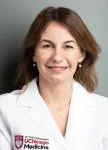(Press-News.org) The risk of skin cancer, malignant melanoma, now appears to be decreasing in Sweden - at least in those under 50, according to a new study.
“We can see a trend break in young adults around 2015 where the incidence curves are falling,” says first author Hildur Helgadottir, senior consultant and associate professor of oncology at the Department of Oncology-Pathology, Karolinska Institutet.
She and her research colleagues have analyzed data from the Swedish Melanoma Registry and followed melanoma incidence and mortality for different age segments over time. This means that they have compared individuals in a certain age range at one point in time with individuals in the same age range at another point in time.
The results show that the new-onset curves for people over 50 years of age are steadily increasing, but for the age groups younger than 50 years, the new-onset curves started to decrease around 2015.
“This is the first time we see this in Sweden, and we are actually the first European country to report a decline,” says Hildur Helgadottir.
In terms of mortality, the curves have also turned downwards for ages up to 59, but not for those over 60. Hildur Helgadottir believes that the decrease in mortality in the younger groups is due both to a reduction in the incidence of the disease and to the introduction of new oncological drugs that have improved the prognosis for the disease. She believes that the fact that mortality is not decreasing in the elderly is because the incidence of the disease is still so high in this group.
“The question is why the risk of melanoma has decreased.
“We have not directly analyzed the causes in our study, but we have hypotheses about factors that we believe have interacted,” says Hildur Helgadottir.
“There are four main factors,” she says.
The first is increased awareness of sun protection.
“The first national 'Sun Safe' campaign in the 1990s specifically highlighted the importance of protecting children. About 20 years later, we believe that this has led to a reduction in the incidence of the disease in younger adults,” says Hildur Helgadottir.
Another factor is that access to sunbeds has decreased drastically. Since 2018, there has been an 18-year age limit on sunbeds, but the number of public sunbeds decreased much earlier.
Third, mobile phones and computers mean that children and young people are spending more time indoors and are not exposed to sunlight in the same way today.
Finally, immigration means that there are more individuals in Sweden with darker pigmentation who can tolerate the sun better.
“We see that it is necessary to continue the work of emphasizing the importance of sun protection so that the reduction of melanoma in younger people is maintained and that the incidence will eventually also decrease in older people,” says Hildur Helgadottir.
Hildur Helgadottir points out how necessary it is to continue to emphasize the importance of sun protection so that the reduction of melanoma in younger people is sustained and that the incidence will eventually decrease in older people as well.
“We are having an unusually warm and sunny September. It is important to remember that from April to September the sun can be strong and you should be careful,” says Hildur Helgadottir.
The research was funded by the Swedish Regional Cancer Centers, the Swedish Cancer Society, Region Stockholm, and the Research Funds of Radiumhemmet, among others. The researchers report that there are no conflicts of interest.
Publication: “Melanoma incidence and mortality trends in Sweden”, Hildur Helgadottir, Rasmus Mikiver, Karina Schultz, Kari Nielsen, Francesca Portelli, Jan Lapins, Susana Puig, Karolin Isaksson. JAMA Dermatology online September 9, 2024, doi: 10.1001/jamadermatol.2024.3514
Facts: Malignant melanoma
Malignant melanoma is a form of skin cancer that starts in the pigment cells (melanocytes) at the bottom of the epidermis. It is the second most common cancer among both women and men, after breast cancer and prostate cancer. Each year, around 5 000 people are diagnosed with malignant melanoma and around 500 die from the disease. The average age at diagnosis is just over 60 years, but each year around 750 people are diagnosed between the ages of 20 and 49.
There is a clear link between skin cancer and the sun's ultraviolet radiation, which causes damage to the genetic material of cells. The risk of melanoma is increased in people who have been highly exposed and have had many burns from sunlight or tanning beds. It is considered particularly risky to get such damage as a child and adolescent because the skin is more vulnerable than in an adult.
Malignant melanoma is more common in people with fair skin; in people with dark skin, malignant melanoma is uncommon. Melanin-rich skin provides good protection against the disease. However, malignant melanoma and other forms of skin cancer can affect anyone, regardless of skin type.
Source: Swedish Cancer Society and National Board of Health and Welfare.
END
Breaking the trend: Skin cancer incidence in young adults declines
2024-09-09
ELSE PRESS RELEASES FROM THIS DATE:
ChatGPT outperformed trainee doctors in assessing complex respiratory illness in children
2024-09-09
The chatbot ChatGPT performed better than trainee doctors in assessing complex cases of respiratory disease in areas such as cystic fibrosis, asthma and chest infections in a study presented at the European Respiratory Society (ERS) Congress in Vienna, Austria [1].
The study also showed that Google’s chatbot Bard performed better than trainees in some aspects and Microsoft’s Bing chatbot performed as well as trainees.
The research suggests that these large language models (LLMs) could be used to support trainee doctors, nurses and general practitioners to triage patients more quickly and ease pressure on health services.
The ...
Night owls are more likely to develop type 2 diabetes – and it’s not just because of an unhealthy lifestyle, Dutch study finds
2024-09-09
Night owls have a higher BMI, larger waists, more hidden body fat and are almost 50% more likely to develop type 2 diabetes (T2D) than those who go to bed earlier, new research to be presented at the Annual Meeting of the European Association for the Study of Diabetes (EASD) in Madrid, Spain (9-13 September), has found.
Lead researcher Dr Jeroen van der Velde, of Leiden University Medical Centre, Leiden, Netherlands, says: “Previous studies have indicated that a late chronotype – preferring to go to bed late and wake up later – is associated with an unhealthy lifestyle. Late chronotypes are ...
Air travel may affect insulin pump delivery in people with type 1 diabetes
2024-09-09
Altitude changes during commercial flights may affect the blood glucose levels of people with type 1 diabetes who are treated with insulin pump therapy, according to new research to be presented at this year’s Annual Meeting of The European Association for the Study of Diabetes (EASD), Madrid (9-13 Sept).
“We investigated the effect atmospheric pressure changes during flight can have on insulin pumps following concerns that glucose levels may drop below the normal ranges during or immediately after flights,” explained lead author Dr Ka Siu Fan from the Royal Surry County Hospital and University ...
Fruit and oats raise risk of type 1 diabetes but berries provide protection, research suggests
2024-09-09
New research being presented at the annual meeting of the European Association for the Study of Diabetes (EASD) in Madrid, Spain (9-13 September), shows that eating fruit, oats and rye in childhood is associated with a higher risk of developing type 1 diabetes (T1D). Eating berries, however, is linked to lower odds of developing the condition.
T1D is an autoimmune condition in which the immune system attacks and destroys the insulin-producing islet cells in the pancreas. This prevents the body from producing enough of the hormone insulin to properly regulate blood sugar levels.
What triggers the immune system’s attack is unknown but is thought to involve a combination ...
Patients receiving steroids are more than twice as likely to develop diabetes, UK study has found
2024-09-09
Patients who are being treated with systemic glucocorticoids are more than twice as likely to develop diabetes as those not receiving the treatment, the Annual Meeting of the European Association for the Study of Diabetes (EASD) in Madrid, Spain (9-13 September) will hear.
Glucocorticoids (sometimes known as steroids) fight inflammation and are used to treat a wide range of inflammatory and autoimmune conditions, including asthma, rheumatoid arthritis, cancers and other medical problems.
While they can be very effective in decreasing inflammation, glucocorticoids have many adverse effects including ...
Perioperative nivolumab may provide meaningful improvement in event-free survival compared to only neoadjuvant nivolumab plus chemotherapy for resectable NSCLC
2024-09-08
(San Diego, Calif--September 8, 2024, 10:05 a.m. PCT) – New data from landmark analysis presented today report a decreased risk of disease recurrence or death in patients with resectable NSCLC who received adjuvant nivolumab following neoadjuvant nivolumab plus chemotherapy and surgery compared to those who received only neoadjuvant nivolumab plus chemotherapy.
The data was reported at the International Association for the Study of Lung Cancer 2024 World Conference on Lung Cancer.
This is the first analysis of individual patient-level data from two phase 3 trials, CheckMate 77T and CheckMate 816, to examine which patients may derive benefit from ...
PanCan nodule management protocol more effective than LungRADSv1.1 method
2024-09-08
(San Diego, Calif.--September 8, 2024, 10:05 a.m. PCT) – New data presented today reveals that the PanCan nodule management protocol demonstrates superior performance in triaging lung cancer screening participants compared to the LungRADSv1.1 approach. Specifically, PanCan showed improved risk stratification and reduced the number of low-dose computed tomography(CT) scans required.
The research was reported by Dr. Annette McWilliams, Fiona Stanley Hospital, Australia at the International Association for the Study of Lung Cancer 2024 World Conference on Lung Cancer.
The ...
Normalized membrane ratio of TROP2 by quantitative continuous scoring predictive of clinical outcomes in TROPION-Lung 01
2024-09-08
(San Diego, Calif.--September 8, 2024, 10:05 a.m. PCT) – New data presented today demonstrate that TROP2 expression as measured by quantitative continuous scoring (QCS), a computational pathology approach, is a promising predictor of clinical outcomes in patients with advanced or metastatic non-small cell lung cancer (NSCLC) treated with the TROP2 antibody-drug conjugate (ADC) datopotamab deruxtecan (Dato-DXd). The data showed that patients with TROP2 positivity, as determined by QCS, experienced improved efficacy with Dato-DXd compared to patients receiving docetaxel ...
Ivonescimab outperforms pembrolizumab in phase 3 study for first-line treatment of PD-L1-positive advanced NSCLC in HARMONi-2 study
2024-09-08
(San Diego, Calif--September 8, 2024, 8:30 a.m.) — Data from a Phase 3 study revealed that ivonescimab demonstrates a statistically significant and clinically meaningful improvement in progression-free survival compared to pembrolizumab for patients with PD-L1-positive advanced non-small cell lung cancer. The results were presented today at the International Association for the Study of Lung Cancer (IASLC) 2024 World Conference on Lung Cancer.
The HARMONi-2 study randomized 398 patients ...
NeoCOAST-2 Data shows combination of Durvalumab with novel agents increases pathological responses in resectable NSCLC -- Data builds on AEGEAN study research
2024-09-08
(San Diego, Calif. September 8, 2024 10:05 a.m. PCT) – Phase 2 results from the NeoCOAST-2 study demonstrated that the combination of durvalumab with Dato-DXd yielded the highest pathological complete response rates among the tested regimens.
The data was presented at the International Association for the Study of Lung Cancer (IASLC) 2024 World Conference on Lung Cancer by Dr. Tina Cascone, from The University of Texas MD Anderson Cancer Center in Houston.
“The findings highlight the potential of combining durvalumab with novel anticancer agents to build on what we have learned in the perioperative immunotherapy arena for patients with ...





